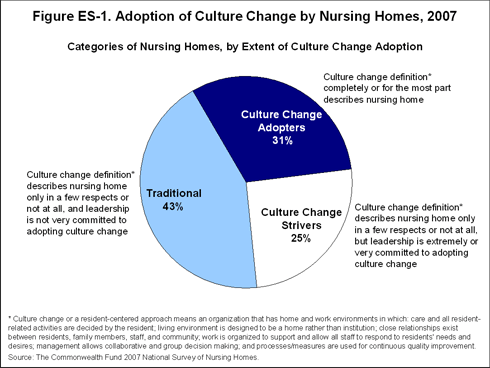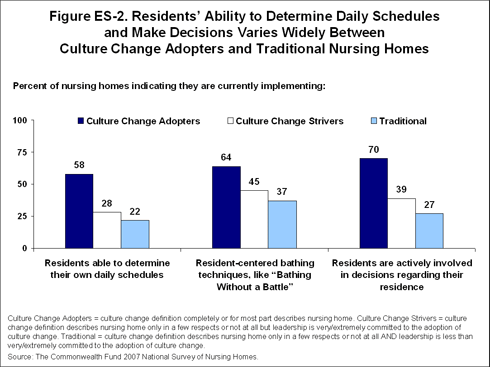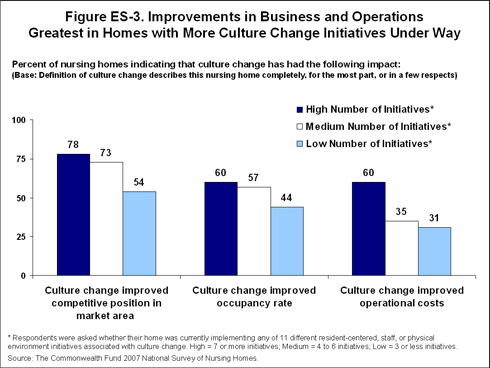Background
The Nursing Home Reform Act, passed in 1987, established quality standards for nursing homes nationwide, emphasized the importance of quality of life, and preserved residents' rights. However, despite enactment of this law, serious concerns remain about the quality of care provided to residents in the nation's 16,000 nursing homes. To improve the quality of care and the quality of life for nursing home residents, a growing movement, known as "culture change," is working to deinstitutionalize long-term care and radically transform the nursing home environment.
In the culture change model, which has gained momentum over the past decade, seniors enjoy much of the privacy and choice they would experience if they were still living in their own homes. Residents' needs and preferences come first; facilities operations' are shaped by this awareness. To this end, nursing home residents are given greater control over their daily lives—for instance, in terms of meal times or bed times, and frontline workers—the nursing aides responsible for day-to-day care—are given greater autonomy to care for residents. In addition, the physical and organizational structure of facilities is made less institutional. Large, hospital-like units with long, wide corridors are transformed into smaller facilities where small groups of residents are cared for by a consistent team.
The Commonwealth Fund 2007 National Survey of Nursing Homes
In the past decade, there has been growing awareness of culture change among professionals and providers in the field, but the extent to which nursing homes across the country have adopted a resident-centered culture is still unknown. In 2007, The Commonwealth Fund conducted a nationally representative survey of nursing homes to learn more about the penetration of the culture change movement at the national level and measure the extent to which nursing homes are adopting culture change principles and practicing resident-centered care. A representative sample of 1,435 nursing homes was surveyed between February and June 2007.
The questionnaire was administered to directors of nursing who were asked about three domains of culture change: resident care, staff culture and working environment, and physical environment. Specifically, the survey examines whether nursing homes have adopted practices that make care more resident-directed, that engender a work environment that fosters staff autonomy and decentralized decision-making, and that alter the physical environment to make their facilities look and function like a home, rather than a hospital.
Although survey results are mixed regarding the degree to which nursing homes report they have adopted resident-centered practices, findings indicate a hopeful picture about the potential for deep, systemic change within the industry. Four or five years ago, few nursing homes were familiar with the term "culture change." Today it is recognized by and familiar to almost all providers. If the first step to change is awareness of a problem and the availability of an alternative, then the field of nursing home care is indeed poised for transformation.
Furthermore, the survey shows that in facilities that incorporate some aspects of culture change, the more culture change initiatives that are under way, the greater the benefits in terms of staff retention, higher occupancy rates, better competitive position, and improved operational costs. As the awareness of these and other competitive and operational advantages becomes more widely known, it is likely that many more nursing homes will begin to shift toward making the changes in human resource management, the physical environment, and care delivery that are the hallmarks of resident-centered care.
Highlights From the Survey
Using self-reported data from directors of nursing, we categorized nursing homes that participated in the survey as culture change adopters, culture change strivers, or traditional nursing homes (Figure ES-1).

- Culture change adopters. Only 5 percent of nursing homes report that the definition of culture change or resident-directed care "completely" describes their home. An additional 25 percent indicate that their nursing home "for the most part" fits the description of a culture change. A total of 31 percent of surveyed nursing homes are considered culture change adopters (numbers do not add because of rounding).
- Culture change strivers. The 25 percent of nursing homes in this category indicate that the definition of culture change describes their nursing home "in a few respects" or "not at all" but leadership is "extremely" or "very" committed to adopting culture change.
- Traditional nursing homes. The remaining 43 percent of facilities that fall into this group say that the definition of culture change describes their nursing home "not at all" or only "in a few respects" and the leadership is only "somewhat," "not very," or "not at all" committed to the adoption of culture change (Figure ES-1).
In general, nursing homes have been most successful at increasing residents' involvement in decision-making, and there is some evidence that management is accommodating collaborative and decentralized decision-making to empower direct-care workers. However, very little organizational redesign has penetrated the field and very few homes have changed their physical environment to support culture change.
Culture change adopters are more likely than traditional facilities to implement resident-centered care approaches. The survey finds that there is wide variation among nursing homes in terms of the choices and autonomy given to residents and in providing environments that are resident-centered (Figure ES-2). About 30 to 40 percent of all nursing homes report they are currently implementing some principle of culture change that fosters resident-directed care, including allowing residents to determine their own daily schedules, practicing resident-centered bathing techniques, or by actively involving residents in nursing home decisions.

- Fifty-eight percent of culture change adopters allow residents to determine their own schedules, compared with only 22 percent of traditional nursing homes (Figure ES-2).
- Nearly two-thirds (64%) of culture change adopters implement bathing practices that are more resident-centered, while only 37 percent of traditional nursing homes do so.
- Seven of 10 culture change adopters report that residents are involved in decisions about their facility, but only one-quarter of traditional nursing homes (27%) involve residents in such decisions.
Culture change adopters have initiated a range of staff empowerment initiatives. Overall, a minority of nursing homes have undergone organizational changes, such as supporting a team approach for workers or cross-training staff, which makes the organization less hierarchical and empowers direct care nursing home staff. But, direct care workers are more likely to have leadership opportunities and be authorized to make decisions about delivering resident care in nursing facilities that self-identify as culture change adopters.
- Overall, just over half of nursing homes (53%) provide staff with leadership training opportunities but only 15 percent indicate that they currently enable direct care workers to create self-managed work teams and only 14 percent currently cross-train staff to play several functional roles (for example, housekeeping, nursing, food service, and activities) to serve a variety of resident needs.
- Among culture change adopters, one third (32%) support self-managed work teams yet far fewer traditional homes do so.
- Fifty-nine percent of culture change adopters include direct care workers and residents on the senior management team, compared with only 24 percent of traditional nursing homes.
- Culture change adopters are more likely than traditional homes to consistently assign the same aides to residents (86% vs. 74%).
Very few homes are altering their physical environments. Very few nursing homes have renovated their traditional nursing units into "neighborhoods"—smaller functional areas that can include common community and dining areas—or "households," which are small home settings with a full kitchen, dining room and living areas for 25 or fewer residents and their dedicated staff. Even culture change adopters have difficulty altering their physical environments to make facilities more home-like.
- On average, nursing homes report that only 8 percent of residents currently reside in neighborhoods and only 1 percent live in households.
- Only 16 percent of culture change adopters report they are currently breaking down large units into smaller operational units and only 7 percent have eliminated large nursing stations, which are often given prominent placement in the center of the unit in institutional-style nursing homes.
- While more nursing homes are making the dining experience resident-centered, progress in this area is still slow. About three of 10 nursing homes (29%) in the U.S. indicate they have implemented initiatives to make dining less institutional, such as offering restaurant, family, and buffet styles and providing more dining times.
- Nearly half (46%) of culture change adopters report they have changed how meals are served. In contrast, only 22 percent of traditional homes report they are making such changes.
The more culture change principles are embraced, the greater the increase in staff retention and occupancy rates and the greater the decrease in operational costs. As nursing homes become more engaged in culture change and adopt more of its associated practices, staff retention, market competitiveness, occupancy rates, and operational costs also improve (Figure ES-3).

- Among facilities that are engaged in some aspect of culture change, 78 percent currently implementing seven or more culture change initiatives report that culture change has improved their competitive advantage in their market area. In contrast, only 54 percent of nursing homes that are implementing three or fewer culture change initiatives report such an improvement.
- Another 60 percent of nursing homes that are currently implementing at least seven or more culture change initiatives report improved occupancy rates, while only 44 percent with three or fewer culture change initiatives under way reportthis improvement.
- Half of nursing homes that are most engaged in culture change report that staff absenteeism decreased; in contrast, only one-third of nursing homes with three or fewer culture change initiatives under way report this improvement in staff absenteeism.
Committed leadership can be a driver of culture change. Nursing homes that are considered strivers—that is, they are not yet culture change adopters, but have leaders who are committed to culture change and resident-directed care—are similar to the culture change adopters in their ability to provide resident-directed care. They also demonstrate that they are moving toward being the type of facility that empowers workers, provides direct-care workers with leadership opportunities, encourages decentralized decision-making, and allows staff to make decisions about resident care. Indeed, culture change strivers reported significantly more positive responses on all measures related to improving staff working environments, compared with traditional nursing homes. These findings reiterate the importance of a committed leadership for encouraging culture change.
The Commonwealth Fund 2007 National Survey of Nursing Homes finds that while many nursing homes are aware of the "culture change" movement, progress has been slow in transforming long-term care facilities from institutions to homes. But with the examples and best practices gleaned from the culture change movement, nursing homes can begin to make the necessary changes to improve the quality of life for their residents and staff.



